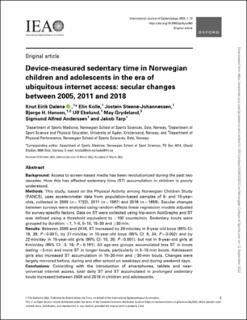Device-measured sedentary time in Norwegian children and adolescents in the era of ubiquitous internet access: Secular changes between 2005, 2011 and 2018
Dalene, Knut Eirik; Kolle, Elin; Steene-Johannessen, Jostein; Ekelund, Ulf; Grydeland, May; Anderssen, Sigmund Alfred; Tarp, Jakob; Hansen, Bjørge Herman
Peer reviewed, Journal article
Published version
Permanent lenke
https://hdl.handle.net/11250/3017683Utgivelsesdato
2022Metadata
Vis full innførselSamlinger
- Artikler / Articles [2119]
- Publikasjoner fra Cristin [1107]
Sammendrag
Background: Access to screen-based media has been revolutionized during the past two decades. How this has affected sedentary time (ST) accumulation in children is poorly understood.
Methods: This study, based on the Physical Activity among Norwegian Children Study (PANCS), uses accelerometer data from population-based samples of 9- and 15‐year-olds, collected in 2005 (n = 1722), 2011 (n = 1587) and 2018 (n = 1859). Secular changes between surveys were analysed using random-effects linear regression models adjusted for survey-specific factors. Data on ST were collected using hip-worn ActiGraphs and ST was defined using a threshold equivalent to <100 counts/min. Sedentary bouts were grouped by duration: <1, 1–5, 5–15, 15–30 and ≥30 min.
Results: Between 2005 and 2018, ST increased by 29 min/day in 9-year-old boys (95% CI: 19, 39; P <0.001), by 21 min/day in 15-year-old boys (95% CI: 8, 34; P = 0.002) and by 22 min/day in 15-year-old girls (95% CI: 10, 35; P <0.001), but not in 9-year-old girls at 6 min/day (95% CI: -3, 16; P = 0.191). All age-sex groups accumulated less ST in bouts lasting <5 min and more ST in longer bouts, particularly in 5–15-min bouts. Adolescent girls also increased ST accumulation in 15–30-min and ≥30-min bouts. Changes were largely mirrored before, during and after school on weekdays and during weekend days.
Conclusions: Coinciding with the introduction of smartphones, tablets and near-universal internet access, total daily ST and ST accumulated in prolonged sedentary bouts increased between 2005 and 2018 in children and adolescents.
Beskrivelse
This is an Open Access article distributed under the terms of the Creative Commons Attribution License (https://creativecommons.org/licenses/by/4.0/), which permits unrestricted reuse, distribution, and reproduction in any medium, provided the original work is properly cited.
